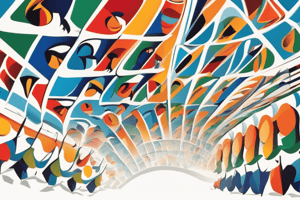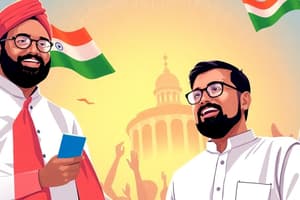Podcast
Questions and Answers
Which political party in India has its roots in nationalism, secularism, and democracy?
Which political party in India has its roots in nationalism, secularism, and democracy?
- Communist Party of India (CPI)
- Congress Party (correct)
- Bharatiya Janata Party (BJP)
- Regional Political Parties
In which Indian states has the Communist Party of India (CPI) been in power for several years?
In which Indian states has the Communist Party of India (CPI) been in power for several years?
- Uttar Pradesh and Maharashtra
- Rajasthan and Gujarat
- Karnataka and Andhra Pradesh
- West Bengal and Kerala (correct)
When was the Communist Party of India (CPI) founded?
When was the Communist Party of India (CPI) founded?
- 1947
- 1960
- 1885
- 1925 (correct)
Which political party has been a major force in Indian politics since 1885?
Which political party has been a major force in Indian politics since 1885?
Which political party in India is inspired by Marxist-Leninist ideology?
Which political party in India is inspired by Marxist-Leninist ideology?
Which political party in India is inspired by Hindu nationalism?
Which political party in India is inspired by Hindu nationalism?
Who has been the Prime Minister of India since 2014?
Who has been the Prime Minister of India since 2014?
Which party has been in power at the center for most of India's independent history?
Which party has been in power at the center for most of India's independent history?
Which party is a major force in Indian politics and is based on linguistic, ethnic, or regional identities?
Which party is a major force in Indian politics and is based on linguistic, ethnic, or regional identities?
Which party forms alliances with national parties to form governments at the center and in various state assemblies?
Which party forms alliances with national parties to form governments at the center and in various state assemblies?
What is one of the main criticisms of the theory that parties are produced by social cleavages?
What is one of the main criticisms of the theory that parties are produced by social cleavages?
How do political parties help in coordinating candidates across geographic districts?
How do political parties help in coordinating candidates across geographic districts?
Why might political parties out-compete unaffiliated politicians?
Why might political parties out-compete unaffiliated politicians?
What is a potential drawback of a legislature consisting of unaffiliated members?
What is a potential drawback of a legislature consisting of unaffiliated members?
What aspect of party formation provides compatible incentives for candidates and legislators?
What aspect of party formation provides compatible incentives for candidates and legislators?
What is one of the core explanations for the existence of political parties?
What is one of the core explanations for the existence of political parties?
Why do many political scientists consider countries with fewer than two parties to necessarily be autocratic?
Why do many political scientists consider countries with fewer than two parties to necessarily be autocratic?
What has led researchers to remark that the existence of political parties is almost a law of politics?
What has led researchers to remark that the existence of political parties is almost a law of politics?
In what way are the politics of many autocratic countries organized?
In what way are the politics of many autocratic countries organized?
Why do political scientists consider countries with fewer than two parties to potentially be autocratic?
Why do political scientists consider countries with fewer than two parties to potentially be autocratic?
Flashcards are hidden until you start studying
Study Notes
Political Parties in India
India, the world's largest democracy, has a diverse and complex political landscape. The country has a multi-party system, with numerous political parties representing various ideologies, interests, and regions. In this article, we will explore some of the major political parties in India, including the Communist Party of India (CPI), Congress Party, Bharatiya Janata Party (BJP), and Regional Political Parties.
Communist Party of India (CPI)
The Communist Party of India (CPI) was founded in 1925 by a group of communist leaders who were expelled from the Indian National Congress. The party is inspired by Marxist-Leninist ideology and has been a part of various left-wing alliances in India. The CPI has been a significant force in Indian politics, particularly in West Bengal and Kerala, where it has been in power for several years. The party has also been a part of various coalition governments at the center and in various state governments.
Congress Party
The Indian National Congress, also known as the Congress Party, is one of the oldest and most prominent political parties in India. It was founded in 1885 and has been a major force in Indian politics ever since. The party has a diverse ideology, with its roots in nationalism, secularism, and democracy. The Congress Party has been in power at the center for most of India's independent history and has produced some of the country's most prominent leaders, including Jawaharlal Nehru, Indira Gandhi, and Rajiv Gandhi.
Bharatiya Janata Party (BJP)
The Bharatiya Janata Party (BJP) is a right-wing political party in India that was founded in 1980. The party is inspired by Hindu nationalism and has been a major force in Indian politics in recent years. The BJP has been in power at the center since 2014 and has also formed governments in several other states. The party's leaders include Narendra Modi, who has been the Prime Minister of India since 2014.
Regional Political Parties
India's regional political parties are an important part of the country's political landscape. These parties are often based on linguistic, ethnic, or regional identities and have significant influence in their respective regions. Some of the major regional parties in India include the Dravida Munnetra Kazhagam (DMK) in Tamil Nadu, the Trinamool Congress in West Bengal, and the Telangana Rashtra Samithi (TRS) in Telangana. These parties often form alliances with national parties to form governments at the center and in various state assemblies.
In conclusion, India's political parties are diverse and represent various ideologies, interests, and regions. These parties play a crucial role in shaping the country's political landscape and determining its policies and governance
Studying That Suits You
Use AI to generate personalized quizzes and flashcards to suit your learning preferences.




